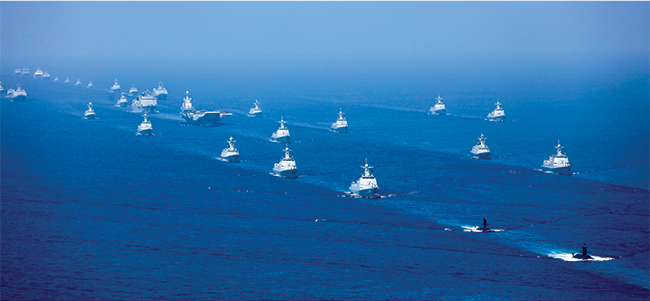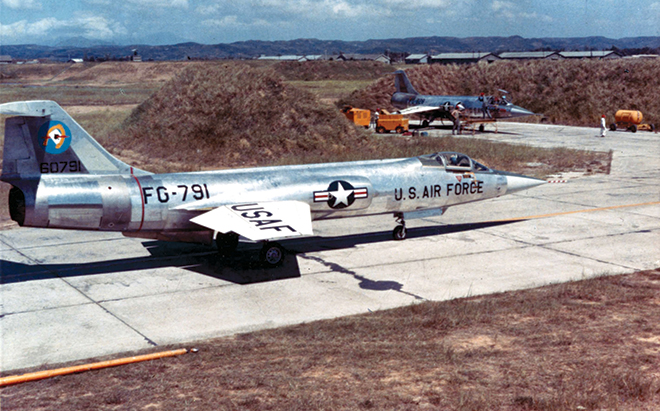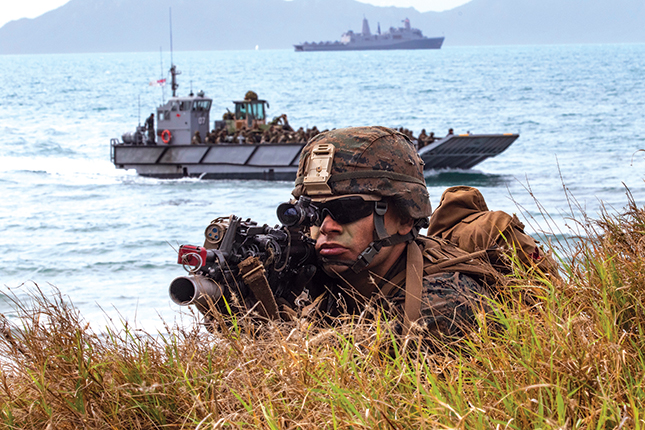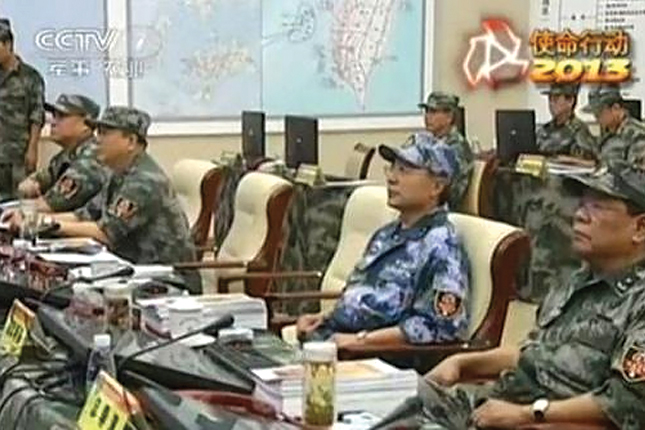Capt. Walker D. Mills

During the Cold War, the primary objective of the U.S. military’s conventional deterrence was to prevent a Soviet invasion of Western Europe and most of the literature on conventional deterrence focused on Europe. Since then, the collapse of the Soviet Union and the expansion of the NATO alliance to include many post-Soviet states have dramatically lowered the threat of a conventional invasion of Western Europe. While there remains a risk of fait accompli actions and other malign behavior, the overall risk does not compare with the risk of invasion during the height of the Cold War. Meanwhile, the United States has “pivoted” to Asia and is primarily concerned with an aggressive and “revisionist” People’s Republic of China, also called mainland China.1 China has made it clear that it views the Republic of China (hereinafter referred as Taiwan) as its most important “core interest” and that it would use force to prevent full Taiwanese independence. Chinese leadership has also made clear that they intend to reunify Taiwan with mainland China by 2049.2 Parallel to increasingly assertive rhetoric from Chinese leadership, the People’s Liberation Army (PLA) has undergone a dramatic modernization and is rapidly approaching parity with U.S. forces in some areas and has surpassed U.S. forces in others like intermediate range missiles.3 Current trends including the increasingly assertive Chinese claims over Taiwan, an increasingly potent and aggressive Chinese military, and the U.S. pivot to Asia have set the stage for escalation and potential confrontation over Taiwanese sovereignty. The United States needs to recognize that its conventional deterrence against PLA action to reunify Taiwan may not continue to hold without a change in force posture. Deterrence should always be prioritized over open conflict between peer or near-peer states because of the exorbitant cost of a war between them. If the United States wants to maintain credible conventional deterrence against a PLA attack on Taiwan, it needs to consider basing troops in Taiwan.
Assessing Intentions
Assessing the intentions or redlines of foreign governments is particularly difficult, and the United States has an imperfect track record with China after major miscalculations regarding Chinese intervention in the Korean War. However, Chinese leadership has made their intention to reunify Taiwan and China by force, if necessary, unequivocally clear. They have never wavered from their “One China” policy and have been calling for PLA invasion of Taiwan since 1949.4 Since at least 1993, the PLA has held up a potential cross-strait operation as their number one strategic priority.5 Some analysts like Toshi Yoshihara and James R. Holmes argue in the book Red Star over the Pacific that Taiwan is even more valuable to China than many Western analysts recognize in the minds of mainland leadership.
[The Taiwan Issue] involves far more than sovereignty and national dignity, the motives Westerners commonly impute to China. Taiwan’s return to mainland rule would buttress China’s strategic position, broaden access to resources and trade, and brighten the prospects for restoring China’s rightful standing in Asia.6
Ian Easton, a senior researcher at a China-focused think tank, has emphasized this as well, writing:
Invading Taiwan is at the heart of the armed wing of the CCP… The war plan for fighting a Taiwan “liberation” campaign is tattooed on the PLA’s corporate memory.7
The United States’ increasingly complicated relationship with China casts doubt on U.S. intentions regarding the defense of Taiwan. In 1979, it established diplomatic relations with the People’s Republic of China and denormalized its relationship with Taiwan, including ending a mutual defense treaty. At the same time, the United States withdrew its forces from Taiwan, standing down the U.S. Taiwan Defense Command and the dedicated Navy Taiwan Patrol Force.8 Since 1979, the United States has supported Taiwanese defense with intermittent arms sales and strait transits by U.S. warships and Coast Guard vessels but has not returned troops to the island in accordance with the 1979 Taiwan Relations Act. The act, which has been the legal guarantor for U.S. support of a free and independent Taiwan, is somewhat ambiguous. It codifies U.S. policy as:
To provide Taiwan with arms of a defensive character; and to maintain the capacity of the United States to resist any resort to force or other forms of coercion that would jeopardize the security, or the social or economic system, of the people on Taiwan.9

China’s Liaoning aircraft carrier, accompanied by navy frigates and submarines, conducts military exercises 12 April 2018 in the South China Sea. (File photo released by the Xinhua News Agency)
Critically, it is not a mutual defense treaty that obligates the United States to defend Taiwan or to respond to PLA aggression; it is ambiguous in this way and defers the actual decision to use force to U.S. leadership at the time of a crisis. Even before the 1979 withdrawal the United States maintained an intentional level of ambiguity in its commitment to the defense of Taiwan.10 Because the United States does not base forces on Taiwan, conduct joint military training with Taiwanese forces, or have an alliance with Taiwan, the arms sales are the only real demonstration of the U.S. commitment to Taiwanese defense.11 Thomas C. Schelling, one of the fathers of compellence theory, reminds us that “one cannot incur a genuine commitment [to defend another state] by purely verbal means,” because other demonstrations of commitment are essential.12 Ambiguous or uncertain commitments can lead to disastrous miscalculations. It is possible that the Korean War could have been prevented had the United States made clear its willingness to defend South Korea, and that direct Chinese involvement could have been avoided with more effective communication of their redlines as well.13 Both were miscalculations because of a lack of mutual understanding about redlines and intentions. It is more than just a coincidence that again, the United States is dangerously ambiguous about deterrence with China, a country as opaque to Americans as any.
Assessing the Balance of Forces
The local balance of forces in East Asia continues to tip ever more in favor of the PLA. Taiwanese forces have been unable to keep up with the rapid growth and modernization of the PLA and have prioritized “prestige” military capability over the anti-access/area denial (A2/AD) capabilities that would be more effective defending the island against the PLA.14 Because of this, Taiwanese forces, while certainly still capable, are increasingly at risk of having to face PLA overmatch in quantity but also in quality.15 These changes in Taiwan’s threat environment particularly the ambiguous nature of U.S. support and relative changes in the balance of forces are pushing Taiwanese leaders to alter their defensive strategy.16 Perhaps more importantly in the overall balance, U.S. forces no longer boast the overmatch that they enjoyed during the 1995–1996 Taiwan Strait Crisis.17
Unconstrained by the Intermediate-Range Nuclear Forces Treaty, the PLA amassed hundreds of thousands of conventional ballistic missiles that now threaten U.S. ships and bases in Japan, Korea, and even Guam. During the same period the United States lost its bases in the Philippines—critical locations near China and on the South China Sea. The risk to the remaining bases and ships, especially to runways and aircraft carriers, is that China could swiftly neutralize American air and naval power in East Asia during a conflict. This would effectively prevent the United States from interfering with a PLA invasion of Taiwan because the United States does not have any forces in Taiwan.
A 2017 report by the Center for New American Security found that Chinese missiles were “the greatest military threat to U.S. vital interests in Asia.”18
By marrying great accuracy with numerous ballistic missiles, China may have developed a capability that the Soviet armed forces never had: the ability to strike effectively, in a matter of minutes, U.S. and allied bases, logistical facilities, and command centers without resorting to the use of nuclear weapons, and without having established air superiority.19
Later in the year, a RAND research brief came to the same conclusion—that U.S. presence in the region was vulnerable because of the Chinese capability to target U.S. bases, specifically aviation infrastructure, which could be neutralized for at least the first forty days of a conflict—more than enough time for the PLA to gain a foothold in Taiwan.20 Michael Chase’s 2018 testimony before the U.S.-China Economic and Security Review Commission reported on the modernization of PLA capabilities and found that
[the PLA] Rocket Force’s growing conventional ballistic and cruise missile capabilities could pose a serious threat to U.S. forces and those of its allies and partners, including not only fixed facilities such as air bases but also surface ships, such as U.S. aircraft carriers.21
Another analyst called the Kadena Air Base in Okinawa, Japan, a “sitting duck susceptible to missile attacks from the Chinese.”22

A U.S. Air Force Lockheed F-104A Starfighter from the 83rd Fighter Interceptor Squadron stationed at Taoyuan Air Base, Taiwan, participates in Operation Jonah Able 15 September 1958 in response to the Quemoy Crisis. (Photo courtesy of the National Museum of the U.S. Air Force)
Recent commentary has begun to reflect a sense of doom and gloom in the ability of U.S. forces in East Asia to credibly deter Chinese aggression. A steady parade of commentary has identified the vulnerabilities of aircraft carriers and large amphibious ships, the foundation of American deterrence in East Asia.23 A 2018 New York Times article announced that the head of U.S. Indo-Pacific Command, Adm. Phillip Davidson, admitted, “China is now capable of controlling the South China Sea in all scenarios short of war with the United States.”24 The article was focused on the Chinese military buildups on several reefs and artificial islands in the South China Sea, but it came out at the same time as the U.S. military was acknowledging the threat of Chinese missiles to its ships and bases. Gen. Robert B. Neller, the previous commandant of the Marine Corps, expressed a similar pessimism responding to a question about increasing PLA dominance of the South China Sea.
Sadly, I don’t see us doing a whole lot to contest that. [The Chinese] are out there putting their marbles down, and we’ve got no marbles. We’ve got old marbles, but pretty soon there isn’t going to be a place to put down marbles if they don’t start doing something.25
Until recently, American naval forces were enough to credibly deter the PLA from attempting a cross-strait operation. Even though the U.S. Navy’s Taiwan Patrol Force stood down in 1979, the Navy was still very engaged in enforcing the neutrality of the strait. During the 1995–1996 Taiwan Strait Crisis, the Navy sailed two carrier strike groups formed around the USS Nimitz and the USS Independence, through the strait to signal the United States resolve to defend Taiwan against aggression from Beijing. It is highly likely that PLA impotence in the face of the 1995–1996 strait transits provided the impetus for the PLA’s robust A2/AD capability.26 Even as late as 2008, a RAND study found that “successful invasion [of Taiwan] would be nearly impossible for the near term”; however, the study also foreshadowed the current balance of forces, noting that “Chinese force modernization (particularly the acquisition of systems to deny U.S. naval and air assets access to the area around Taiwan) may alter this balance in the next decade.”27

United States Taiwan Defense Command badge
Today, U.S. Navy and Coast Guard vessels make occasional strait transits as part of routine freedom of navigation operations.28 However, these vessels would be extremely vulnerable if caught in the middle of a cross-strait operation and would be unable to prevent a cross-strait operation by the PLA on their own. It is also unlikely that the Navy would send an asset as valuable as a carrier strike group through the Strait of Taiwan today, even though in June 2020, the Navy surged three aircraft carriers to the Pacific.29 It would also be difficult and risky, if not impossible for the United States to surge forces to Taiwan to support the Taiwanese military in the event of a conflict. PLA A2/AD capabilities could easily seal off Taiwan to even the expeditionary forces on the United States bases in Japan and Guam. Surge forces from the U.S. mainland would be weeks if not months away.30
In addition to the expansion of PLA missile capabilities, the People’s Liberation Army Navy (PLAN) has also modernized and expanded its surface and subsurface fleet. A 2015 Office of Naval Intelligence report noted that in 2013 alone, the PLAN launched, commissioned, or laid down more than sixty ships. The report also noted that this level of shipbuilding was “more naval ships than any other country and is expected to continue this trend through 2015–16” and beyond.31 Other analysts noted that the Office of Naval Intelligence, “a body not known for hyperbole,” called the PLAN shipbuilding program “remarkable.”32 This shipbuilding program is all the more threatening to the U.S. ability to reinforce Taiwan because most of the PLAN vessels are armed with anti-ship missiles, and every anti-ship missile in the PLAN outranges the U.S. Navy’s standard anti-ship missile, the Harpoon.33 Yoshihara and Holmes ultimately concluded in their book on the subject,
If our diagnosis is correct, the United States and its allies are in a danger zone. … The martial balance may continue shifting toward the PLA in the coming years as Chinese forces expand, improve their arsenal and refine their tactics to make the best use of the contested zone.34
A 2015 Center for Strategic and Budgetary Assessments report, Deploying Beyond Their Means: America’s Navy and Marine Corps at a Tipping Point, found that the Navy and Marine Corps are overextended and in many cases, unable to do much more than exist at forward locations in the Pacific.35 This point was underscored by the 2017 USS Fitzgerald and USS John S. McCain collisions, which were attributed to a lack of personnel readiness and training in the Seventh Fleet. The Marine Corps commitments to the region have also been lagged over recent years as it prioritized ongoing combat operations in U.S. Central Command over rotational deployments to Okinawa and Australia. However, this year, the commandant of the Marine Corps, Gen. David Berger, announced that the corps would reprioritize operations in the Pacific.36 The U.S. Army, despite having a Pacific presence similar in size to the Marine Corps, continues to prioritize deterrence in Europe, and even within U.S. Indo-Pacific Command, it is focused on deterring North Korea rather than China.

Lance Cpl. Tyler Pearson watches his sector of fire 22 July 2019 during an amphibious assault on Kings Beach while participating in Exercise Talisman Saber 2019 in Queensland, Australia. To neutralize potential enemy capabilities resulting from the construction and militarization of artificial islands in the South China Sea, the Marine Corps is building a Marine littoral regiment specifically designed for island hopping offensive operations against defending enemy forces in a contested environment. The design of this force reduces the kinds of conventional equipment that can potentially slow quick-strike capabilities and will emphasize the employment of lethal air and ground unmanned platforms, long-range surface and subsurface vehicles, electronic warfare, and a greatly increased number of precision guided munitions, among other organizational and equipment innovations. Such a regiment could be maintained afloat or be stationed permanently at a forward deployed location. (Photo by Sgt. 1st Class Whitney C. Houston, U.S. Army)
Deterrence
The concept of deterrence has benefited from considerable academic study, though not as much of it has been devoted to East Asia, or specifically to the issue of Taiwan; most studies have focused on nuclear deterrence issues or deterrence in Western Europe. According to Alexander L. George and Richard Smoke in Deterrence in American Foreign Policy, deterrence is defined as “the persuasion of one’s opponent that the costs and/or risks of a given course of action he might take outweigh its benefit.”37 Karl P. Mueller described conventional deterrence “distilled to 140 characters” as “deterrence is causing someone not to do something because they expect or fear that they will be worse off if they do it than if they do not.”38 Robert Ross explained deterrence with regard to Taiwan in International Security:
Effective deterrence demands that the status quo state possess the retaliatory capability to inflict costs that outweigh the benefits on a state that seeks to change the status quo. U.S. deterrence in the Taiwan Strait requires that Chinese leaders believe that the United States can use its military capabilities effectively in a war in the Taiwan theater and that it can inflict sufficient costs on China that outweigh the benefits of unification through war.39
In Taiwan’s case, it is helpful to break deterrence down into two components: the perceived ability to prevent a PLA invasion (often called denial) and the perceived ability to effectively respond to one with force and fight a larger conflict.40 The distinction is important because it is now likely that the United States has little or no ability to prevent such an action. Chinese missiles and missile-armed bombers could, with little or no warning, cripple the U.S. aviation support infrastructure in East Asia and neutralize flat-deck Navy vessels in the opening hours of a conflict. By targeting runways, China could prevent the United States from bringing other aircraft into theater, and China could use its considerable number of surface ships and submarines to prevent or delay the arrival of out-of-theater U.S. naval assets. The United States would still retain a long-range bomber force capable of striking PLA targets and probably submarine assets capable of striking targets on land and at sea. However, unsupported, these assets would be vulnerable to Chinese fighter aircraft and antisubmarine warfare efforts, respectively. A surprise PLA attack on U.S. forces and Taiwan could effectively isolate Taiwan from U.S. support and prevent U.S. interference in a cross-strait invasion for days, if not weeks. A RAND study found that with only 274 missiles (a small fraction of the PLA inventory), the PLA could keep Kadena Air Force Base in Okinawa close to fighter operations for thirty days and three times as long for tanker operations.41 This would be adequate time for the PLA to gain a foothold in Taiwan and expand its air defense umbrella across the strait. Similarly, a more limited PLA strategy of blockade or an extended air and missile campaign would effectively preclude U.S. forces from defending Taiwan later.
The second component of deterrence, the ability to react, now becomes important. The United States would be faced with the choice of acquiescing to the PLA invasion of Taiwan, a near fait accompli at this point, or marshaling forces to attempt a much larger and longer campaign to roll back the PLA A2/AD umbrella and ultimately land forces on Taiwan to reinforce the Taiwanese military or retake the island. Because the United States is reacting and could have been isolated from providing immediate support to Taiwan, the decision to intervene and support Taiwan becomes a deliberate rather than reflexive choice.
American leadership and the public may, at that juncture, decide that the sovereignty of Taiwan is not worth the cost of that larger campaign and a potentially much larger war with Beijing. In his 2013 essay on deterrence, Richard K. Betts argued that the political will to support Taiwan militarily in a crisis was an open question.
There is no serious discussion about this, let alone consensus, among either U.S. voters or the foreign policy elite in Washington.42
In his book Conventional Deterrence, John Mearsheimer outlines his own theory of deterrence. His study focuses closely on conventional deterrence in Europe at the end of the Cold War, though his conclusions apply to the Taiwan case. Mearsheimer argues that deterrence fails when one side believes it has a relatively cheap way to achieve its objectives, which is often what he calls “the quick land grab.”43 He calls this the “limited aims strategy,” writing,
When strategic surprise is possible, the limited aims strategy has a high probability of success; it is simply not as ambitious a strategy as one that aims at decisive defeat of the enemy.44
If the PLA believes it can quickly achieve its “limited aim” of repatriating Taiwan through surprise and a lightning maritime campaign, U.S. deterrence based offshore is likely to fail. “In a crisis, if one side has the capability to launch a blitzkrieg, deterrence is likely to fail.”45 Robert Ross echoed the same argument in “Navigating the Taiwan Strait”:
Deterrence can also fail when the deterrer’s military strategy cannot eliminate the challenger’s option of a fait accompli strike that achieves the challenger’s limited objectives and leaves war initiation or escalation to the deterrer. In the Taiwan Strait, failed conventional deterrence could entail China starting a war to seek the rapid political capitulation of Taiwan. Thus, effective deterrence requires the United States to possess the specific capabilities necessary to frustrate a fait accompli strategy.46
The larger risk to the PLA is a protracted war with the United States—a short, yet bloody conflict with Taiwan may be an acceptable price for reunification. Ross argues that what makes deterrence work is when an attacker (in this case China) does not believe they can rapidly achieve their limited aims and would face a larger and riskier war of attrition.
Deterrence is likely to hold when a potential attacker is faced with the prospect of employing an attrition strategy … the possibility of becoming engaged in a long, costly war, even if success could be guaranteed, is a powerful deterrent to military action.47
To effectively deter China and the PLA, America needs to posture its forces in a way that would inevitably trigger a larger conflict and make plain its commitment to Taiwanese defense. American forces cannot be postured in a way where they could simply be isolated from the conflict by PLA A2/AD capabilities and a debilitating strike on their bases.

Soldiers of the People’s Liberation Army oversee military exercises while a map of Taiwan prominently hangs in the background. (Photo by the South China Morning Post)
Altering the Balance: Returning U.S. Forces to Taiwan
It is time to consider returning U.S. forces to Taiwan. The presence of U.S. ground forces in Taiwan would significantly alter the deterrence paradigm and prevent Mearsheimer’s blitzkrieg and fait accompli attacks or any misunderstanding of the United States’ intentions. Forces in Taiwan would also communicate the message the United States will defend Taiwan in the clearest terms, in Schelling’s words this communication is the “hardest part of deterrence.48 The United States needs to “make [deterrence] persuasive, to keep it from sounding like a bluff.”49 A 2020 RAND study on the value of heavy ground forces for conventional deterrence concluded “our results provide consistent evidence for the deterrent effects of heavy ground forces and air defense capabilities.”50 This finding was in comparison to the deterrent effect of light forces, mobile and sea forces, and also crisis deployments. The study found that crisis deployments, which are short-term deployments to deescalate a particular crisis at a particular time, had valuable deterrent effects but were limited in their ability to “prevent no-notice or short-notice faits accomplis launched by highly capable adversaries [emphasis in original].”51 It also found “little, if any, evidence for the deterrent impact of air and naval forces.”52
Ground forces based in Taiwan would not only be important for repelling a PLA invasion, but more importantly, they would act like what RAND calls a “tripwire”; that is, “smaller numbers of ground forces stationed to ensure that U.S. forces quickly become directly involved in a potential adversary invasion.”53 A small force would be economical and minimally antagonistic toward mainland China especially if it was only a rotational force. It would have the deterrent effect of assuring the PLA that in the event of a cross-strait invasion, U.S. forces would be committed to the defense of Taiwan, avoiding what Betts called “the most dangerous long-term risk posed by Washington’s confusion over deterrence”—lack of a clear message to Beijing.54 Another RAND article on deterrence argued, “A defender can succeed by deploying sufficient local forces to raise the cost of a potential attack, to make escalation inevitable, and to deny the possibility of a low-risk fait accompli.”55
U.S. ground combat forces are the most capable in the world, and it would be extremely unlikely that the U.S. government would not commit to a larger conflict after U.S. ground forces were engaged in Taiwan. Such a force would also allow U.S. and Taiwanese forces to train and exercise together like U.S. forces routinely do with South Korean, Japanese, and Filipino forces.
This year, the U.S. Marine Corps announced significant future changes in the way it mans, organizes, and equips the force so that it can operate as an “inside force” in the first island chain. This reorganization will allow the corps to operate in accordance with its new operating concept, Expeditionary Advanced Base Operations.56 The Marine Corps envisions itself operating as a highly mobile and distributed force using precision fires and unmanned aviation to strike PLA targets on land and at sea. This vision has been widely lauded; however, even the Marine Corps is unlikely to be able to prevent a PLA assault without basing these forces in Taiwan. Even the projected Marine Corps capabilities will not be able to reach the Strait of Taiwan from potential operating sites in Japan or the Philippines. Also, the authors of a 2018 RAND study found that
light ground forces, particularly when deployed directly inside the borders of the partner or ally being threatened, may be associated with a higher risk of low-intensity militarized disputes, but we do not find similar evidence of this risk for heavy ground forces in our statistical models.57
This finding stands in contrast to the Marine Corps’ own conclusions that a lighter, more mobile force can provide superior deterrence than the medium-weight force that exists today. The Marine Corps recently announced that it was divesting of all of its tanks, reducing its number of attack helicopters, and reducing its purchase of F-35B fighter jets.58 The Marine Corps’ vision offers another path to effective conventional deterrence; however, that vision is still predicated on being at the point of crisis in time to prevent a fait accompli or blitzkrieg attack, which would potentially require forces based in Taiwan.

The Evolution of Military Strategy in Taiwan (Figure from the Taiwan National Defense Report–2019, https://www.ustaiwandefense.com/tdnswp/wp-content/uploads/2020/02/Taiwan-National-Defense-Report-2019.pdf)Enlarge the figure
Similarly, the U.S. Air Force has been experimenting with a new concept Agile Combat Employment, where small, self-sufficient groups of tactical forces can be surged forward and operate from improvised or dual-use facilities in a crisis.59 However, like Expeditionary Advanced Base Operations, Agile Combat Employment still requires access to the operational area and basing infrastructure in order to be effective. Also, while certainly a force multiplier, airpower alone has been historically ineffective in both deterrence and coercion.60
It is critical to recognize that basing U.S. forces in Taiwan would likely be considered an escalatory move by the People’s Republic of China and that such a move would likely have other impacts in U.S. foreign policy beyond Taiwan. The full range of potential consequences of this decision are beyond the scope of this paper but would need to be thoroughly considered. Any U.S. forces in Taiwan would also have require an invitation by the Taiwanese government, something likely to provoke significant internal debate in Taiwan. On the other hand, the loss of Taiwan as a friendly nation would throw the larger U.S. military strategies for defending Japan or the Philippines into disarray; control of Taiwan would give the PLA unfettered access to the Pacific Ocean and break any defensive strategy centered on the First Island Chain.
Conclusion
The United States needs to consider basing ground forces in Taiwan if it is committed to defending Taiwanese sovereignty. The regional balance of power in East Asia continues to tilt away from the United States and Taiwan toward mainland China. More specifically, the contours of the power balance make the possibility of a surprise, or fait accompli, attack on Taiwan more likely. If PLA forces can prevent U.S. forces from responding reflexively or immediately to PLA aggression, the United States will either accede to a quick PLA victory in a Taiwanese-mainland China conflict, or be forced to wage a long, costly campaign to reestablish access to Taiwan with a far from certain outcome. U.S. leadership may have to face down domestic pressure at home and international pressure abroad against a deliberate and more global conflict with China.
U.S. ground forces in Taiwan, particularly combat credible, heavy forces could not only go far in repelling a PLA cross-strait operation but also serve as a tripwire that would inevitably trigger a wider conflict not acceptable to China. Most importantly, the presence of ground forces sends a clear message that the United States will support Taiwan militarily in a conflict with mainland China. These forces would also be able to train with Taiwanese forces and make it easier for follow-on U.S. forces to flow into Taiwan in the event of a conflict. If the United States is serious about Taiwanese defense, then it needs forces in Taiwan. Without U.S. forces in Taiwan, it is increasingly likely that China will attempt to integrate Taiwan into its republic by force. If current trends continue as projected and the United States does not increase its presence U.S. deterrence will continue to erode, paradoxically increasing the risk of conflict.
No comments:
Post a Comment